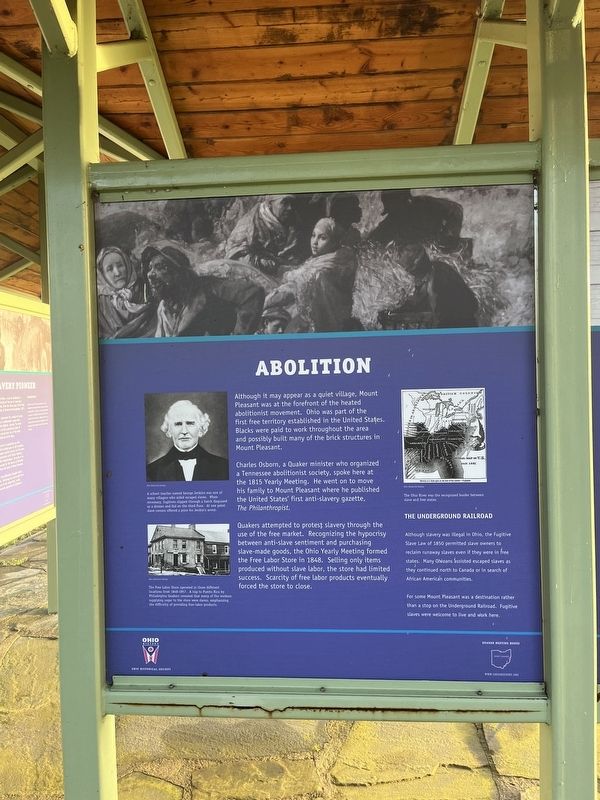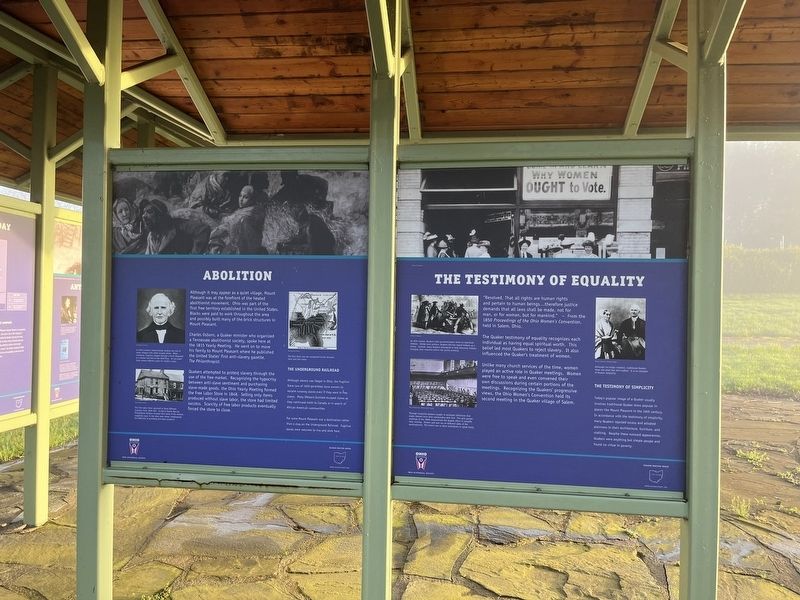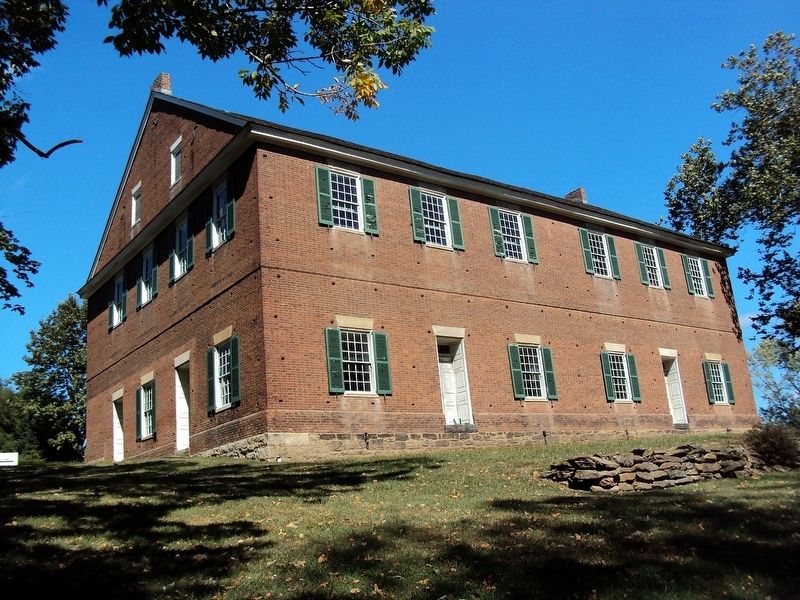Mount Pleasant in Jefferson County, Ohio — The American Midwest (Great Lakes)
Building the Meetinghouse / Abolition
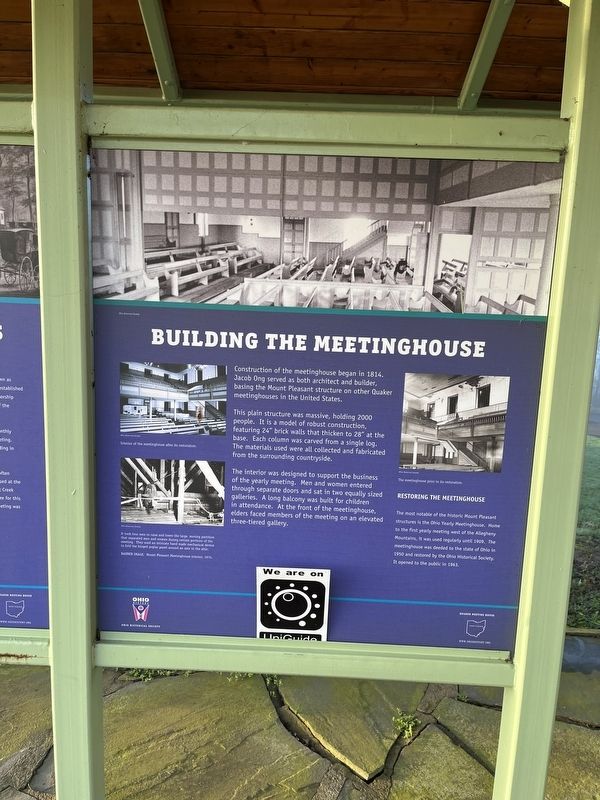
Photographed By Devry Becker Jones (CC0), April 22, 2022
1. Building the Meetinghouse side of the marker
Building the Meetinghouse
Construction of the meetinghouse began in 1814. Jacob Ong served as both architect and builder, basing the Mount Pleasant structure on other Quaker meetinghouses in the United States.
This plain structure was massive, holding 2000 people. It is a model of robust construction, featuring 24" brick walls that thicken to 28" at the base. Each column was carved from a single log. The materials used were all collected and fabricated from the surrounding countryside.
The interior was designed to support the business of the yearly meeting. Men and women entered through separate doors and sat in two equally sized galleries. A long balcony was built for children in attendance. At the front of the meetinghouse, elders faced members of the meeting on an elevated three-tiered gallery.
[Sidebar:]
Restoring the Meetinghouse
The most notable of the historic Mount Pleasant structures is the Ohio Yearly Meetinghouse. Home to the first yearly meeting west of the Allegheny Mountains, it was used regularly until 1909. The meetinghouse was deeded to the state of Ohio in 1950 and restored by the Ohio Historical Society. It opened to the public in 1963.
[Caption:]
It took four men to raise and lower the large, moving partition that separated men and women during certain portions of the meeting. They used an intricate hand made mechanical device to fold the hinged poplar panel around an axle in the attic.
Abolition
Although it may appear as a quiet village, Mount Pleasant was at the forefront of the heated abolitionist movement. Ohio was part of the first free territory established in the United States. Blacks were paid to work throughout the area and possibly built many of the brick structures in Mount Pleasant.
Charles Osborn, a Quaker minister who organized a Tennessee abolitionist society, spoke here at the 1815 Yearly Meeting. He went on to move his family to Mount Pleasant where he published the United States’ first anti-slavery gazette, The Philanthropist.
Quakers attempted to protest slavery through the use of the free market. Recognizing the hypocrisy between anti-slave sentiment and purchasing slave-made goods, the Ohio Yearly Meeting formed the Free Labor Store in 1848. Selling only items produced without slave labor, the store had limited success. Scarcity of free labor products eventually forced the store to close.
[Sidebar:]
Although slavery was illegal in Ohio, the Fugitive Slave Law of 1850 permitted slave owners to reclaim runaway slaves even if they were in free
For some Mount Pleasant was a destination rather than a stop on the Underground Railroad. Fugitive slaves were welcome to live and work here.
[Captions:]
A school teacher named George Jenkins was one of many villagers who aided escaped slaves. When necessary, fugitives slipped through a hatch disguised as a dresser and hid on the third floor. At one point slave owners offered a price for Jenkin's arrest.
The Free Labor Store operated in three different locations from 1848-1857. A trip to Puerto Rico by Philadelphia Quakers revealed that many of the workers supplying sugar to the store were slaves, emphasizing the difficulty of providing free-labor products.
The Ohio River was the recognized border between slave and free states.
Erected by Ohio Historical Society.
Topics and series. This historical marker is listed in these topic lists: Abolition & Underground RR • African Americans • Churches & Religion • Communications
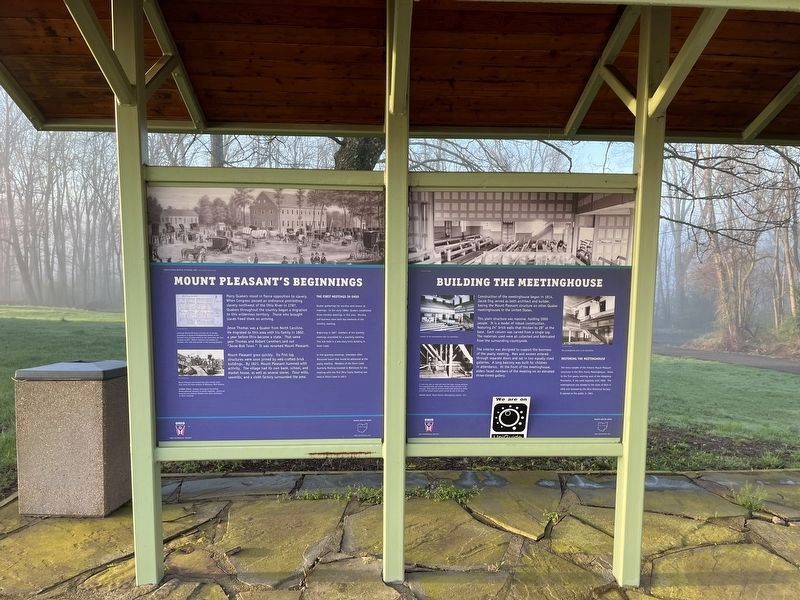
Photographed By Devry Becker Jones (CC0), April 22, 2022
3. Building the Meetinghouse side of the marker
Location. 40° 10.417′ N, 80° 48.176′ W. Marker is in Mount Pleasant, Ohio, in Jefferson County. Marker is at the intersection of Market Street and South Street on Market Street. Touch for map. Marker is at or near this postal address: 298 Market St, Dillonvale OH 43917, United States of America. Touch for directions.
Other nearby markers. At least 8 other markers are within walking distance of this marker. Mount Pleasant's Beginnings / The Testimony of Equality (here, next to this marker); Mount Pleasant Today / What Is A Quaker? (here, next to this marker); Anti-Slavery Pioneer / Schisms (here, next to this marker); Quakers and Wars During the 1900s / Quakers and the Civil War (here, next to this marker); Samuel Gill House (about 500 feet away, measured in a direct line); Benjamin Lundy Home / Free Labor Store (about 500 feet away); Free Labor Store / Benjamin Lundy House
Additional keywords. fair trade; free-labor movement
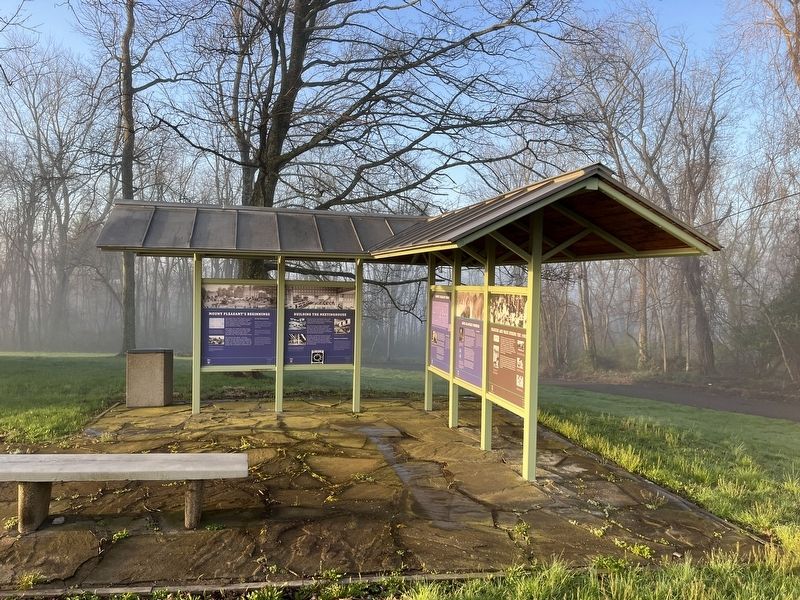
Photographed By Devry Becker Jones (CC0), April 22, 2022
5. The markers display at the old Ohio Yearly Meetinghouse
Credits. This page was last revised on April 23, 2022. It was originally submitted on April 23, 2022, by Jamie Abel of Westerville, Ohio. This page has been viewed 98 times since then and 9 times this year. Photos: 1, 2, 3, 4, 5. submitted on April 23, 2022, by Devry Becker Jones of Washington, District of Columbia. 6. submitted on October 18, 2010, by Jamie Abel of Westerville, Ohio. • Devry Becker Jones was the editor who published this page.
